The newest installment in PBS Wisconsin’s ongoing local history project, Wisconsin Hometown Stories: Beloit tells the story of a city built by industry, education and community pride.
The program premieres 8 p.m. Monday, Oct. 21 on PBS Wisconsin. It will also be available for free online and on the PBS app on streaming devices and smart TVs.
In anticipation of the premiere, PBS Wisconsin spoke with producers Holly De Ruyter and Kyra Lyons about their experience creating the documentary.
PBS Wisconsin: What surprised you the most about making Wisconsin Hometown Stories Beloit?
Holly De Ruyter: One thing that really stood out to me with Beloit’s early history is how much of it was early Wisconsin state history, too. The formation of the city happened 12 years before Wisconsin was even a state. So it was really interesting to learn about how Beloit predated different communities within Wisconsin.
Kyra Lyons: The geography surprised me. Beloit has this beautiful confluence, and I was taken by how the glacier helped shape that rocky river that’s now the Rock River. I also loved discovering the thriving college that looks a lot like a New England college because of the early New England influence of the city. And, it’s the second oldest college in the state!
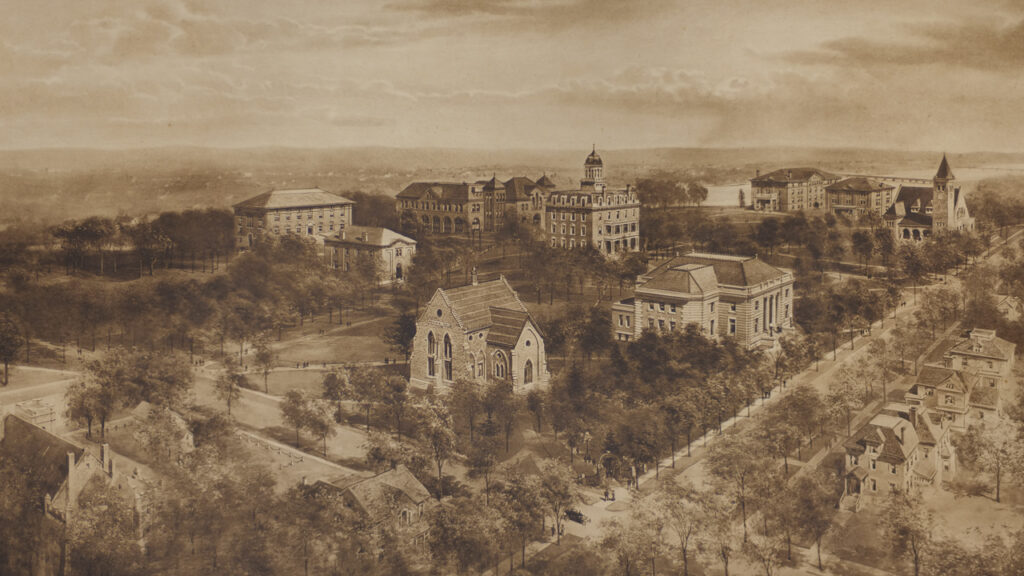
Beloit College early 1900s, courtesy of Beloit College Archive.
PBS Wisconsin: What makes Beloit stand out as a community?
De Ruyter: Throughout time, the Beloit area has been a place for people to settle, to trade and for agriculture. Starting with the Ho-Chunk community, it was a key place in their traditional lands as a stopping point when they were traveling, trade and agriculture. When people of European descent arrived, Beloit appealed to them for the same reasons.
Beloit continues to be a key location in the Midwest today among bigger cities like Milwaukee, Chicago and the Twin Cities, and continues to be a great place for business, for people to live, to find employment, but also for wanting to be close to larger city centers. Beloit fulfills a lot of needs people have been looking for — and has for thousands of years.
Lyons: Another thing that stood out about Beloit is that everyone knows each other. It’s such a tight-knit, engaged community. When we’d be interacting with someone they would know someone else that we had talked to. Everyone was really generous and eager to get this project made and talk to us about their city, how much they love it, and how much they love the history. It was really fun engaging with a community that knows each other so well.
There’s a cultural anthropologist named Margaret Mead who said that Beloit is like America in microcosm, which speaks to how many groups of people are interacting with each other, facing problems together and creating solutions together in Beloit.
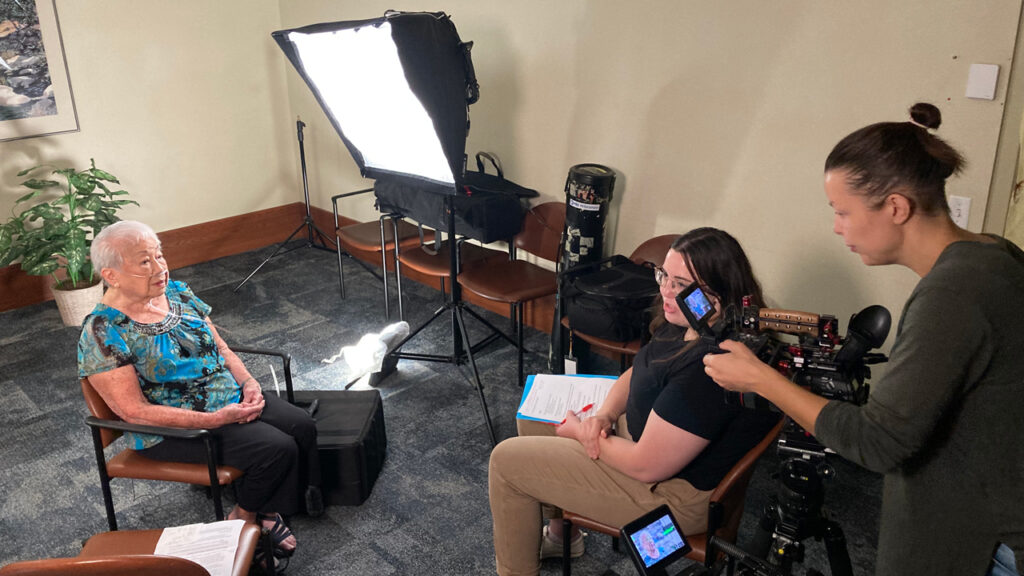
Producer Kyra Lyons and videographer Lina Soblyte interview lifelong Beloit resident Fung Scholz.
PBS Wisconsin: What was your favorite part about making the documentary?
De Ruyter: My favorite part about making the documentary was working with the people in the Beloit community. The passion and pride that the residents of Beloit have is wonderful, and their willingness to share their knowledge and resources with us is really exciting. We could not have made this program and tell the city’s story without their partnership.
We really depend on people. When we make Hometown Stories documentaries, we need people who have done research and have knowledge of their community that can speak to the history. We need access to public and personal archives. We need those materials in order to make a program like this.
PBS Wisconsin could not have made Wisconsin Hometown Stories: Beloit without Beloit. So it’s been really amazing meeting such passionate people who are excited to share the story about their hometown. I think people in Beloit know that there’s some preconceived notions about their city, and we do talk about the tough period it went through, like a lot of Midwestern communities where there was a huge downturn in industrial work.
But, I don’t think a lot of people realize the work that the community did to come together and bring Beloit to where it is today. There’s a lot of people who are really proud to call Beloit home, and we’re really excited that this program gives them a voice to show others why.
Lyons: My favorite part was also just being able to engage with the Beloit community. It was really awesome to see how passionate people were to share stories like, “This is a picture of my mom who came here at this time, and here she is outside of the building that she then lived in for 50 years.” Those moments are really touching.
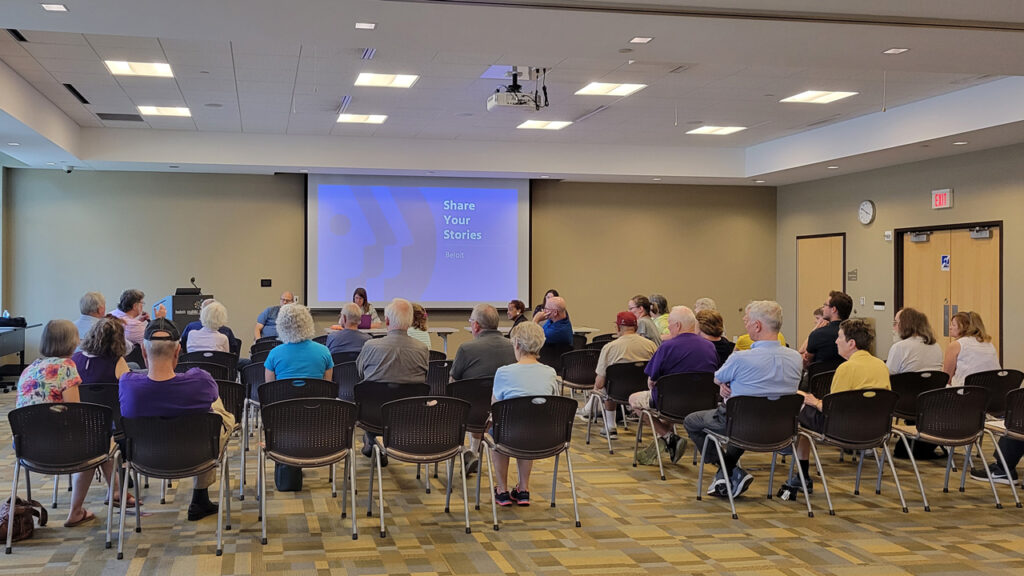
Beloit community archive gathering session.
PBS Wisconsin: What was the most interesting piece of archival material you came across?
De Ruyter: With Beloit being such an early community within the state — we’re talking pre-photographic era — we have sketches and maps, but it’s very challenging finding material to use. So we’re always grasping for any visuals that we can get our hands on to help explain the formation of the community and how it started. The New England Emigrating Company is a key part of Beloit’s formation as a city.
And these were people who came from the East Coast. So, how do we talk about these people? How do we show what they did without photographs? Members of the Beloit Historical Society found a record book of the New England Emigrating Company, and then we were able to get creative with those visuals in the documentary. We were very grateful that the Beloit Historical Society dug in their archives to find that material. I don’t know what we would have done without it!
Another one I have to mention is a great find from a big archival source for us, the Beloit College Archives. They have an impressive amount of film in their archive.
Beloit College was a training college for servicemen during World War II on the campus, and there was film footage of it. We looked at all this amazing industry that really grew and peaked during the wartime era, and we were excited to help share the training college story with the community.
After we had access to this amazing film, just like every resource we use in making the documentary, we’re able to digitize it and then share it back to the archive where we borrowed it. Now they have those digitized materials to use for their own future studies, which is an exciting thing to give back to the community.
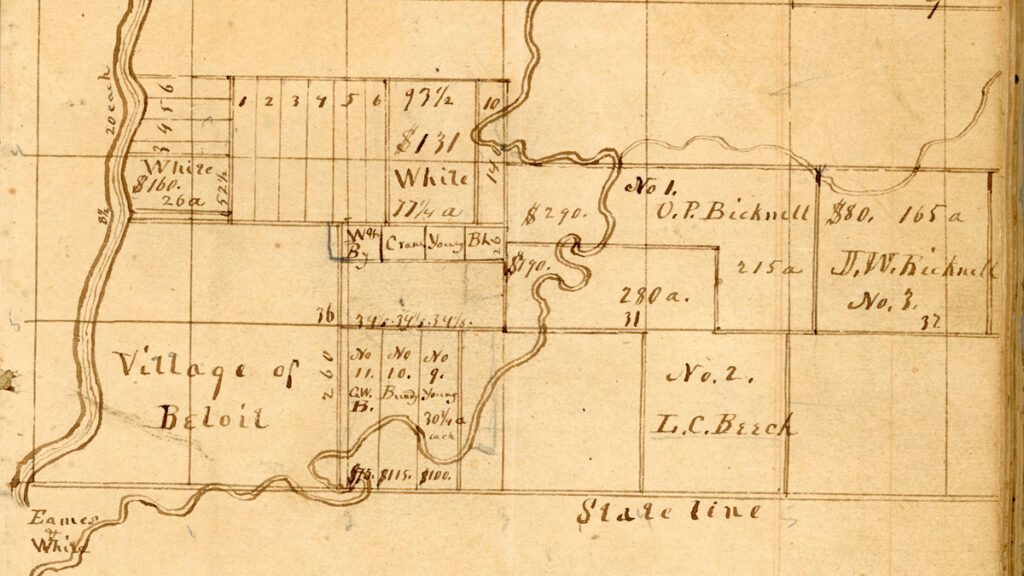
A hand drawn map of the Village of Beloit, courtesy of Beloit Historical Society.
Lyons: At the start of a Wisconsin Hometown Stories project, we host a community archive gathering session. And we never know what material people are going to bring! In Beloit, we had a few people that brought some really amazing material to share with us.
The Delaney’s were one of the biggest families living in Beloit in the early 20th century and they are a really interesting family. Ron and Margaret Delaney brought film to the archive gathering session, which was really exciting. We thought we had no way to watch it, but Ron said, “Oh, I have a projector in my car.” So we watched the film on the wall of the library and that was the start of learning that family’s story. It was really special to have their films from the 1940s through the 1960s and I’m excited for folks to see it in the documentary
Also, Cheryl Caldwell is the founder of the African American Historical Society of Beloit, and she started that organization because she was looking into the history of her family moving to Beloit from Mississippi during the Great Migration. She had all these personal family photos. It’s hard to find photographs of historically underrepresented communities, and she had so many pictures of her family from the South moving to Beloit, at the Fairbanks Flats along the Rock River.
Cheryl had so many beautiful images that were really key images for us in the end, and being able to tell that story was really important for this documentary.
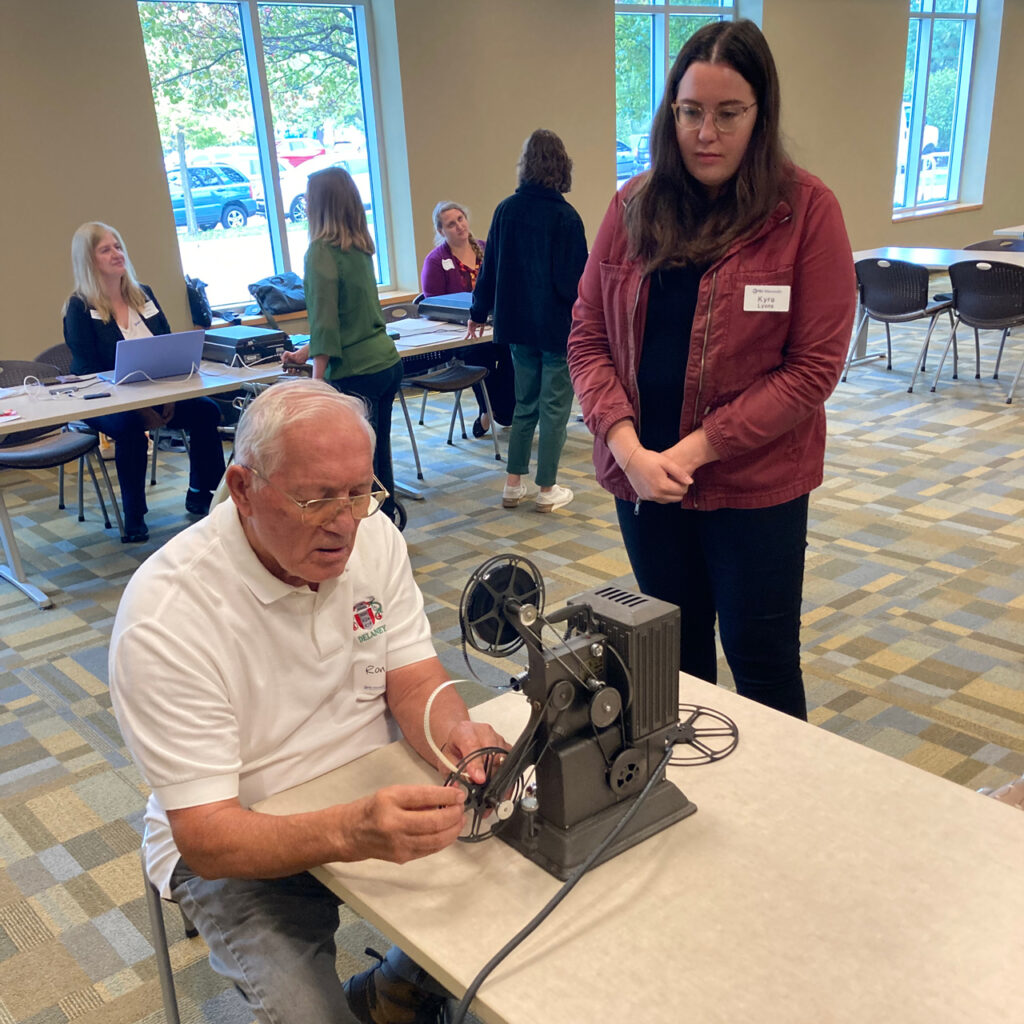
Ron Delaney sets up a projector at the Beloit archive gathering session for producer Kyra Lyons.
PBS Wisconsin: As you researched for the documentary, what were some other stories that you liked but didn’t have time to include in the final production?
De Ruyter: I wish we could have spent more time on agricultural history that happened in Beloit. We didn’t even get to talk about the Dougan Dairy farm, which had a famous round barn. It was very progressive with thinking about the best way to feed and breed cows for dairy production. That’s a huge part of Wisconsin history happening right there in the Beloit area.
Lyons: There are two amazing museums at Beloit College, the Logan Museum of Anthropology and the Wright Museum of Art. They each have a significant historical Beloit figure tied to them. Roy Chapman Andrews was an early student of anthropology at Beloit College, and the Logan Museum houses collections from his expeditions. He was also the inspiration for Indiana Jones!
For the Wright Museum of Art, one of the relatively early art professors at Beloit College who eventually became the first full time director of the museum was O.V. Shaffer. He created a lot of public art in Beloit, and he’s a beloved public artist.
There’s a million other stories about Beloit College. It had such an intriguing campus Civil War involvement. The 1960s had some progressive academics. There was an airplane hangar that they used as a concert space. The college could be its own full own documentary.
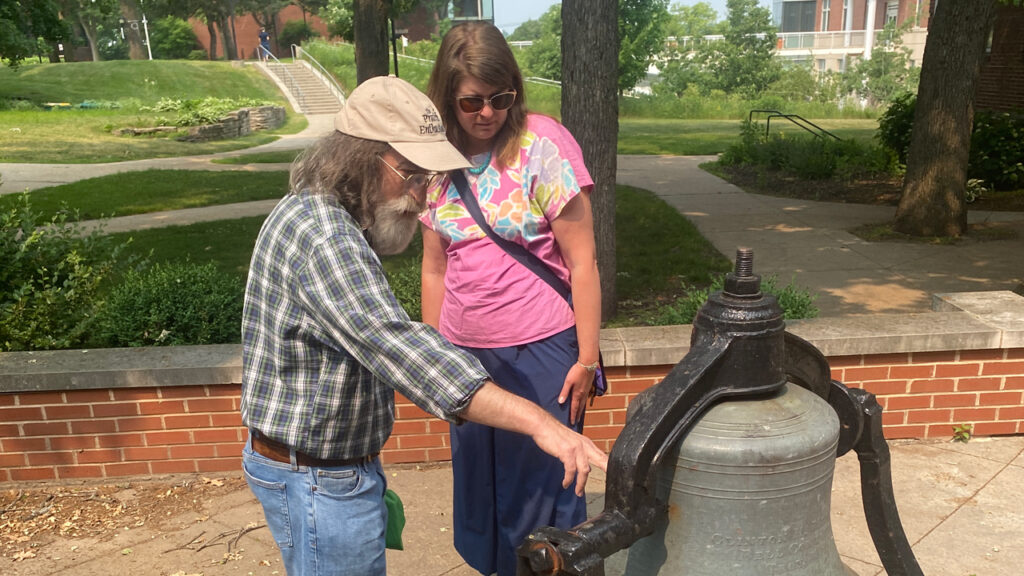
Fred Burwell, archivist emeritus at Beloit College, shows producer Holly De Ruyter around campus.
 Passport
Passport
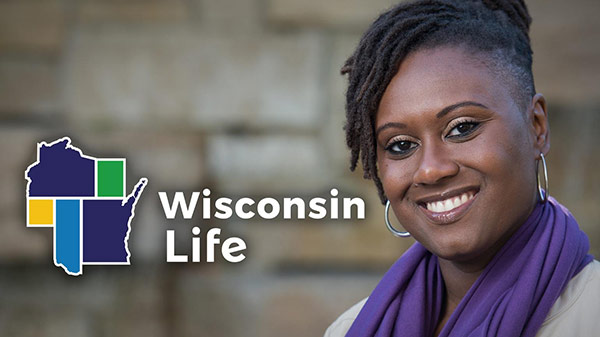









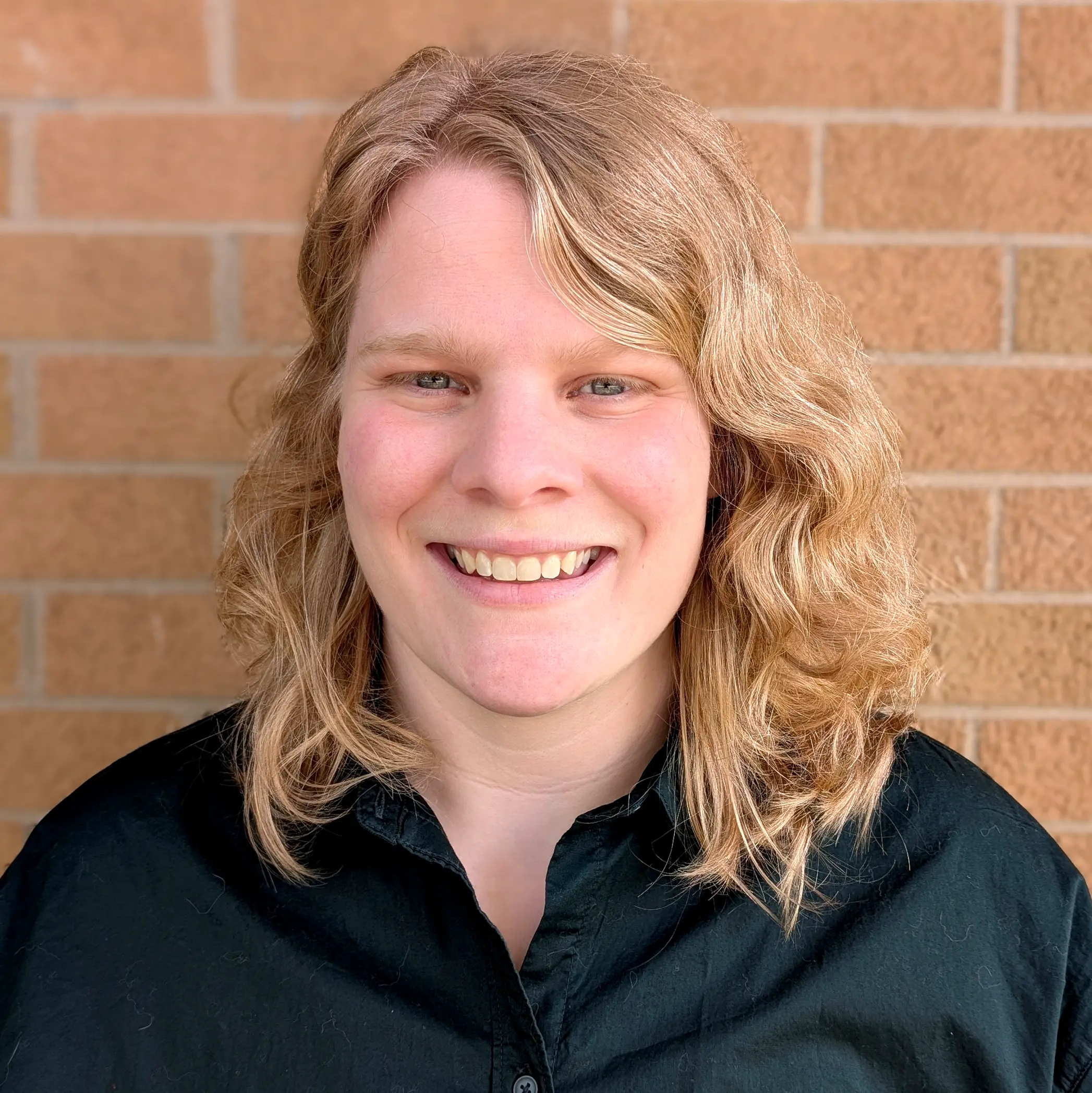

Leslie McKittrick
I’m marking my calendar. Although I’ll turn the doc off if Beloit is mispronounced. It was mispronounced in the trailer. Beloit is pronounced Buh-loyt. Not Buh-loot.
Bruce Bower
A former resident of Beloit, Tom Craddick, has served many years in the Texas House of Representatives, including some years as Speaker. He secured enactment of the law that prohibits texting and driving, among many other enactments.
Jeanne Handy
I wish you had had the opportunity to speak to Jacqueline Dougan Jackson, who is 96 years old and grew up on the Dougan farm. Jackie was a writing professor of mine in Illinois, but she now lives in Delavan, WI. She published a series of books about growing up on the Dougan farm, and her stories transport the reader to a world both comforting and fascinating. Jackie and I still talk frequently, and I enjoy our conversations very much. Your documentary sounds terrific!